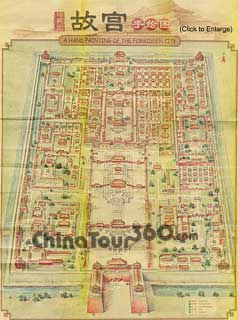Central Axis Route of Forbidden City: Wu Gate - Taihe Gate - Taihe Hall - Zhonghe Hall - Baohe Hall - Qianqing Gate - Qianqing Palace - Jiaotai Hall - Kunning Palace - Imperial Garden - Shenwu Gate
As one of the five greatest palaces in the world, the
Forbidden City is a must-see if you ever have a chance to Beijing. No matter what you are interested in, history, culture or architecture, you will enjoy your trip and have fun there.
To better understand this grand palace, we suggest you hire a professional English-speaking guide at Wu Gate or Shenwu Gate. It is CNY250 for the whole palace, CNY150 for both Central Axis Route and West Route and CNY 100 for Central Axis Route only. Or you can rent an electronic voice guiding machine at CNY40.
If you only have one or two hours' visiting time, you may choose the Central Axis Route of Forbidden City tour starting from Wu Men to see the most important halls. Wu Men is the south gate of the Forbidden City and was a very important place for significant occasions in the Ming and Qing dynasties. After entering the gate, you will see five white marble bridges across the Inner Golden Water River. This man-made river was built for three purposes: the first one is auspiciousness. Together with Jingshan Hill which is opposite to the palace, it creates the best Fengshui to bring the country thriving and prosperity; the second use is water drain. The Inner Golden Water River is connected with the moat and can drain off the rainwater and outlet water out of the palace; the third purpose is the fire extinguishment. The Forbidden City was mainly constructed by wood and easily caught fire. When the fire broke out, the water from the Inner Golden Water River really helped putting it out.
On you left, after passing through Xihe Gate, there is a Paintings and Calligraphy Gallery in Wuying Hall exhibiting precious authentic works of ancient Chinese calligraphic masters and artists. Xiehe Gate on your right leads to the porcelain exhibition in Wenhua Hall. More than 400 carefully selected ceramic art works show the developing history and exquisite craft of Chinese porcelain.
The next on the central axis is Taihe Gate. It was rebuilt in 1889 as the original one was burnt down in 1888. Hongyi Garret is on the left side of Taihe Square and you can visit the Exhibitions of Qing Weapon Equipment and Qing Dynasty Ritual Music. Tiren Garret is opposite to Hongyi Garret and has the exact same architectural form.
|
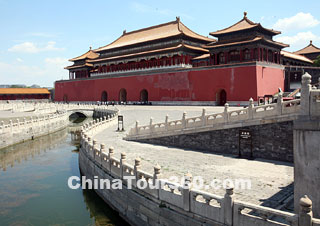
Wu Gate
|
|
|
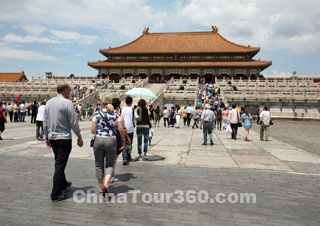
Taihe Hall
|
|
Taihe Hall, Zhonghe Hall and Baohe Hall are the three most important halls and the centers of the Forbidden City.
Taihe Hall is the biggest one where the grand ceremonies like new emperor's enthronement, wedding, birthday or other important announcements were taken place. You may notice that there are 12 little sculptures of animals sitting on each eave of its double-layer arched roof. Most of them were from myths and supposed to protect the building from any evil or disaster. The more of them, the higher-ranking the hall is. Every throne in the palace is unique and the one in Taihe Hall is from the Ming Dynasty. It is 172.5 cm in height and 158.5 cm in width and is made of valuable gold-rimmed nanmu, a kind of wood. Carved with 13 dragons and other elegant and propitious decorative patterns, this throne is the etiquette appliance of the highest grade.
Zhonghe means impartial and appropriate. It reminds the emperors how to be a good head of the empire, handle the national affairs and balance the relationship between the parties.
Baohe Hall is where the emperor feted the civil and military ministers at the lunar New Year's Eve. And every three years, the highest level exam of the country in the feudal imperial examination system was held here and presided over by the emperor. Those who passed the exam would get the degree of 'Jin Shi'. And the first three top were called Zhuangyuan (the number one), Bangyan (the number two) and Tanhua (the number three). In the middle of the steps just behind Baohe Hall, lies the biggest stone carving in China which is 16.57 meters long, 3.07 meters wide and 1.7 meters thick. The whole stone weighs 250 tons and was placed here from the Ming Dynasty, while the pattern was carved again in the Qing Dynasty during the reign of Emperor Qianlong.
|
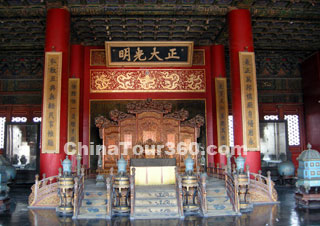
Qianqing Palace
|
|
|
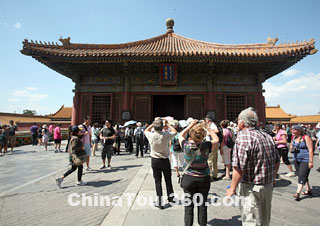
JiaoTai Hall
|
|
After visiting the three halls, you will be at Qianqing Gate, which is the main entrance to the imperial residence of the Forbidden City. In the Qing Dynasty, the emperors met their ministers here to discuss national affairs. In the Ming and early Qing dynasties, Qianqing Palace was the place where the emperors lived and handled daily affairs. Since emperor Yongzheng, the residence had been moved to Yangxin Hall and Qianqing Palace became the place for the royal families' celebrations and for the emperors meeting the officials privately. Also, when an emperor passed away, his coffin would be put here for 3 days for people to mourn. There is a stela hanging in the hall written 'Zheng Da Guang Ming' by the first emperor of the Qing Dynasty, Shunzhi. Besides reminding the monarch to be fair and square, another very important function of this stela is to hide the secret imperial edict which included the name of the prince who was appointed to inherit the throne.
Jiaotai Hall is in the middle of the emperor's residence, Qianqing Palace, and the empress’s residence, Kunning Palace. Jiaotai indicated that the emperor and the empress should be harmonious, associated and should treat each other with the respect and love. On the lunar New Year's Day and the empress's birthday, the concubines, princesses and prince's wives would gather here and celebrate.
The East side of Kunning Palace was where the empress lived and also the place for their wedding night. The rest part of the palace is for Shamanism fete, a religion of Manchu.
The imperial garden is where the royal family spent their time for leisure and recreation in the Forbidden City. The whole garden occupies an area of 11,000 square meters and is filled with old trees, strange stones, exquisite pavilions and elaborate sculptures.
|
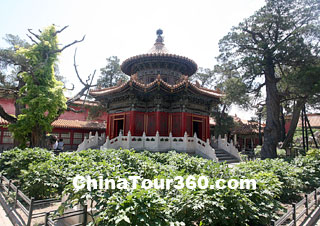
Imperial Garden
|
|
|
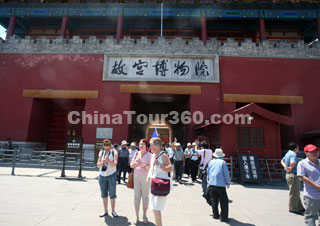
Shenwu Gate
|
|
The north barrier of the palace is Shenwu Gate, the entrance and exit that the empress, concubines and other royal members would use when coming in and going out of the Forbidden City. In the old times, the bell on the gate would be tolled every morning and nightfall, and the drum would be stroke every 2 hours. The tour ends when you step out of the gate. But if you have more time, you may also visit the west and east routes of Forbidden City for more amazing experiences.
